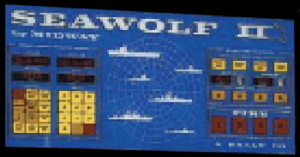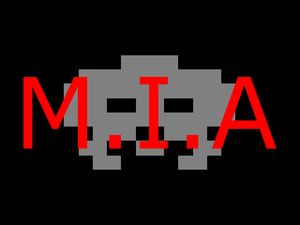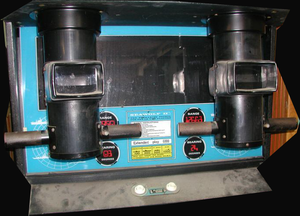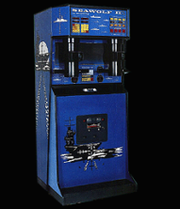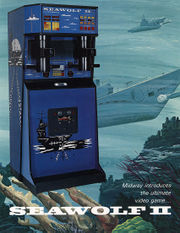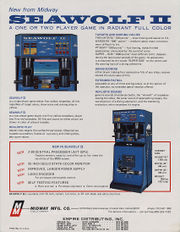Lost In Translation/Sea Wolf II
| Sea Wolf II | |
|---|---|
| Manufacturer | Midway |
| Released | 1978 |
| Control Method |
Paddle 1 Button(s) |
| Main CPU | Z80 (@ 1.790 MHz) |
| Sound CPU | Stereo Discrete |
| Video Details |
Raster (Horizontal) 352 x 240 pixels 60.05 Hz 512 Palette colours |
| Screens | 1 |
| ROM Info | 4 ROMs 8,192 bytes (8.00 KiB) |
| MAME ID | seawolf2 |
About The Game
Sea Wolf II is an arcade video game shoot-em-up.
The game screen is a side view of a underwater scene (with the surface towards the top). You control a cross-hair at the surface level. The object is to shoot as many ships as possible, before the time runs out. Your torpedoes are launched from the bottom of the screen, and must move upwards to hit the enemy ships (while avoiding the mines that float at different levels of the water). There are several different types of enemy ships, from slow moving destroyers, to fast moving PT boats. An 'explosion' light will flash inside your periscope each time you score a hit. Your submarine can shoot five shots before it has to reload (an automatic action that takes about a second). Your game will be extended if you reach a certain score before time runs out (the score is operator adjustable).
Additional Technical Information
This game has one cool looking cabinet. It is in an upright format and is dark blue. The side art is painted on, but is much more subdued than the art on the original "Sea Wolf". Two metal periscopes come down from the marquee area and attach down by the control panel area (or where the control panel would have been, if this game had one). The players look through their periscopes and move them to control the game. They have a fire button mounted on their right handle. The periscopes also have several transparencies inside which provide a cross hair, a display of remaining torpedoes, a reload light, and cause the explosion effect.
Trivia
Released in June 1978, Sea Wolf II is the first-ever sequel! It was basically the exact same game as its predecessor with a few cosmetic improvements.
Still, at least one of the cosmetic tweaks in "Sea Wolf"'s case was a ground-breaker in its own right - though there's some argument over the fact, Sea Wolf II is generally thought to have been the first coin-op to use genuine colour, but was definitely not the first! Real colour had been used as early as 1974 (in "Pace Car Pro") and possibly in 1973 (in "Wimbledon" and the "Color Gotcha"). These games, however, made very limited use of colour (as did others, like Atari's "Sprint 8") and most of them didn't sell very well. Sea Wolf II, on the other hand, sold fairly well and may have been the first game to make extensive use of colour. Sea Wolf II probably represents the very first 'modern' video game.
About 4,000 units were produced.
Series
1. Sea Wolf (1976)
2. Sea Wolf II (1978)
Staff
- Designed & Programmed By
- Tom McHugh
- Dave Nutting
Cabinet and Artwork
Ports
- Computers
- Atari 800 (1983)
- Commodore C64


